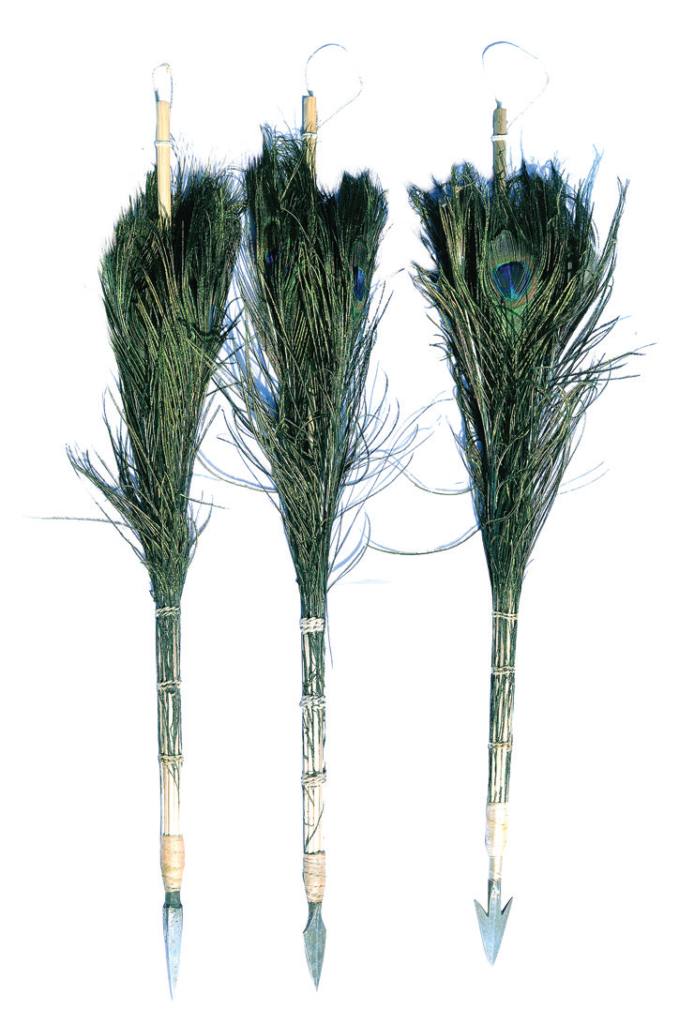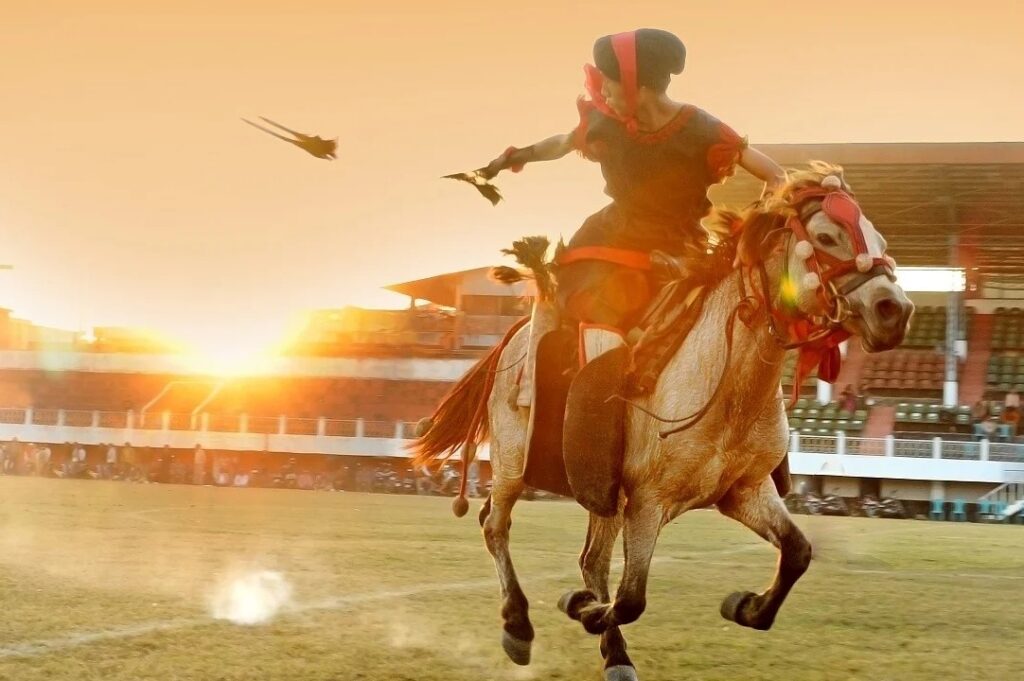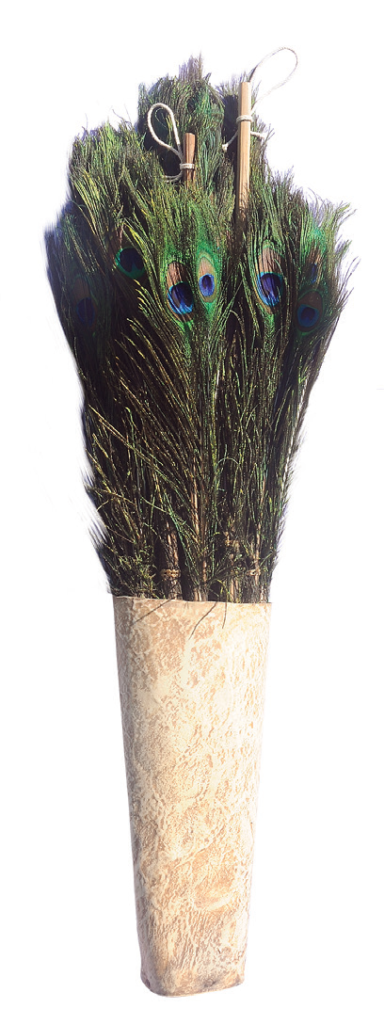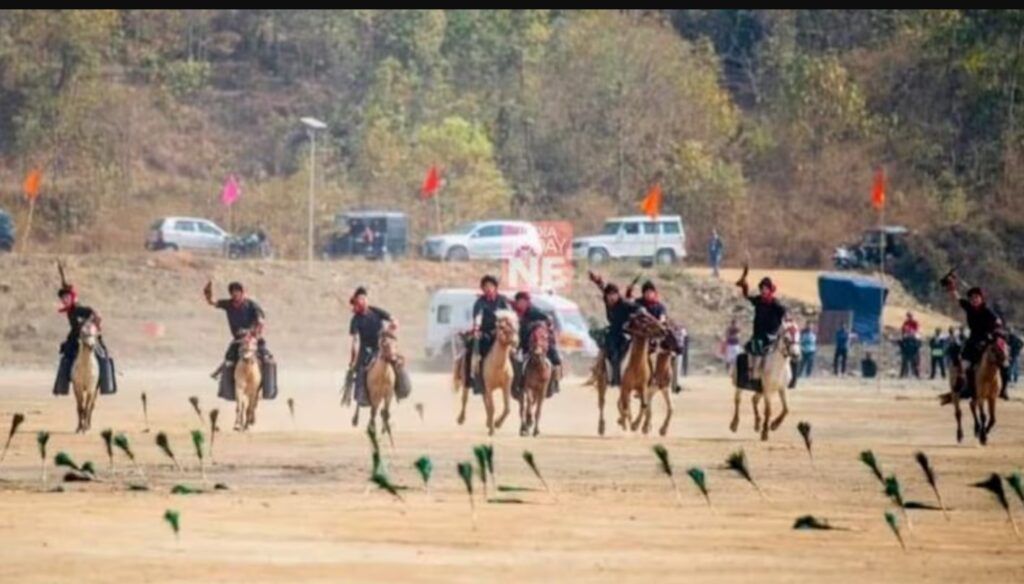Arambai: The Deadly Weapon of the Meitei Cavalry
In a Nutshell
- Weapon type – Dart
- meaning -Arap( far)+pai(fly)
- Country – India
- community – Meitei/ Meetei
- Religion – Sanamahism
- Material -Iron pointed end Peacock feather, Bamboo rod
- Use – Cavalry
- Tactic -Feigned Retreat
- Length – 25 inches
- Others – poisoned tip

Legend says,
“When the Awa (Ava, Burma or Myanmar) soldiers walk, they look up the sky. Their gaze is aimed at the sky so as to avoid showers of the dreaded Manipuri Arambai”. The “gaze” of the Awa is popularly known as Awa Mityeng in Manipuri. Origin of this legend is lost in antiquity. But it is still fondly remembered by the Manipuris signifying how the Manipuri cavalry could afflict terror in the minds of the enemy with the Arambai, a unique weapon of the Manipuri militia.In the annals of ancient warfare, innovative weapons and indigenous tactics often determined the outcome of battles. One such weapon that played a significant role in shaping the destiny of a tiny sovereign nation, Manipur, was the Arambai. This deadly dart weapon was wielded by the Meitei cavalry, mounted on their agile Manipuri ponies.

History
Pony culture in Manipur is as ancient as its inhabitants. Thus, Manipuris believe that Arambai as a weapon of war must have originated since early times and played a pivotal role in the making of the Manipuri nation. There are mentions about use of Arambai during the reign of Meidungu Punshiba (1404–32) who created a permanent military department known as Shingchep Meira Haijouroi, paving the way for the conqueror kings of Manipur in the 15th century. We also come across use of the Arambai by the Manipur cavalry during the reigns of Meidingu Ningthou Khomba (1432–67) and Khunjaoba (1632–66). The Meitei soldiers led by warrior queen Linthoingambi similarly used the Arambai to subjugate internal rebellion when her husband Meidingu Ningthou Khomba was away in a war. The saga of the Arambai wielded by Manipur cavalry was in its highest form of perfection during the reign of Meidingu Pamheiba (1709–54) when he conquered Awa. During his reign, the realm of Manipur extended from the Irrawaddy in the East to Cachar and Tripura in the West. The conquests were possible with the use of highly trained Arambai wielding cavalry that numbered around 3000. Development in weapon systems as well as British colonial administration after Manipur’s defeat in the Anglo-Manipur War of 1891, among others, led to abandonment of the use of Arambai by the Manipuri warriors. T.C. Hodson observed that the introduction of firearms rendered spears, bows, arrows and Arambai, to a large extent, obsolete. After 1891, although Manipur was treated as a “British Protectorate”, the colonial administration effected changes that affected every sphere life – social, political, economic and military. Even when the Manipur Levy was formally abolished and substituted by a standing army in 1835, the Lallup (state militia that also performed peacetime state service) continued to exist. But Major Maxwell’s abolition of the Lallup system on April 29, 1892 had a tolling effect on Arambai warfare.
The Rise of the Meitei Warriors
Manipur, located on the Indo-Myanmar border, boasts a unique history that spans over 2000 years. The Meitei people, also known as Manipuris, were renowned for their prowess in battle. While they employed traditional weapons such as spears and swords, it was their use of the indigenous Arambai that set them apart from their adversaries, particularly the formidable Burmese warriors. “Manipur in old days possessed a famous breed of ponies, larger and better bred than the so-called Burmese ponies that come from the Shan states. On these ponies were mounted the formidable cavalry that in the last century made Manipur feared throughout Upper Burmah, and enabled her rulers on more than one occasion, to carry their victorious arms within sight of Ava, where their Rajah Pamheiba erected a stone pillar to commemorate the event. The cavalry used the regular Manipuri saddle protecting the legs, and were armed with spears and two quivers of darts. These darts in a retreat were grasped by a loop and swung round in a peculiar way, when the shaft formed of peacock feathers with an iron head suddenly became detached, and flying with great force inflicted a fatal wound wherever it struck. A skilful man could throw them with great precision” (Manipur and the Naga Hills originally published under the title My Experiences in Manipur and the Naga Hills, S. Low, Marston and Co., London 1896).
Unveiling the Arambai
Arambai is believed to be the corrupted form of the Manipuri word Arappai (arap = far/distant; pai= to fly; literally meaning to fly to a great distance). The weapon with a total length of around 24–26 inches consists of two parts. In his description of the Arambai, T.C. Hodson states, “It consists,” as Dr. Brown says, “of two parts-one, the outer, is formed of ten or twelve long quills of peacock feathers, which are bound together so as to form a narrow hollow cylinder. At one end is fastened a heavy pointed piece of iron; into the sheath thus formed a bamboo rod is placed, projecting outwards about five inches, and forming a handle; to this handle, to give a better hold, a piece of cord is attached; each horseman had two quivers full of these arambas fixed on either side of his saddle behind; in using them, the handle of the rod, which fitted the sheath with moderate firmness, was grasped firmly and the sheath flung, leaving the bamboo core in the hand; the heavy iron on the point made the aramba fly true. Mounted on their swift Manipuri ponies, the horsemen would whirl the Arambais and release them with unparalleled accuracy and speed, thanks to the galloping momentum. The arrowhead is dipped in poison so that a scratch could kill the enemy. The bamboo rod helps in setting free the arrowhead and the bunch of quills straight to the target. Its main purpose is to increase range and also support the feathers because if they buckled the desired angle for the throw cannot be achieved


Tactics of the Arambai Warriors
The Meitei cavalries were known for their strategic maneuvering on the battlefield. . A well-trained warrior on a galloping Manipuri Pony could freely hurl the weapon in any angle he likes.
1. Feigned Retreat:
One tactic that left their enemies in awe was their feigned retreat, reminiscent of the mighty Mongols. As the Manipuri cavalries appeared to be fleeing, their pursuers would follow closely behind. Suddenly, the Meitei horsemen would execute a swift turn, charging back towards their adversaries, and unleashing a barrage of Arambais with deadly precision
2. Forward charge:
When galloping into the attack, the ponies were trained to turn as soon as the rider had released the Arambai. This kept the horsemen at a safer and longer range from the enemy and they could concentrate on throwing, knowing their horse would retreat as soon as they had thrown.
3. The horsemen can even throw Arambai sideways and even from under the belly of the horse to
inflict fatal injuries to their enemies. When they throw it under the belly, it gave them advantage of using horse as a shield.
How far an Arambai can fly is determined by the speed of the horse, skill and strength of the rider warrior as well as direction of the target. an expert thrower an Arambai can reach a distance of 220 to 270 feet. In addition to other weapons such as sword and spear, cavalry men carried around 50 to 100 Arambais inside a quiver usually made from cow or buffalo hide which are strapped on either side of the saddle, both in front and behind.
The success of the Manipuri cavalry was, however, not solely attributed to their skill with the Arambai. The breed of horses they rode, known as Manipuri ponies, played a crucial role in their triumphs. These medium-sized ponies possessed exceptional adaptability to any environment and were sure-footed, making them ideal for the challenging terrains of Manipur. The Manipuri ponies also exhibited remarkable endurance, allowing the Meitei cavalry to maintain their speed and agility during prolonged battles.
Cassay Horse: Manipuri Cavalry in Burma
The reputation of the Manipuri cavalry extended beyond their homeland. In the 18th century, Manipuri
horsemen joined the Burmese Emperor Alaungpaya’s armies in their wars against the Siamese.John James Snodgrass (1827) in his, Narrative of the Burmese War, states, “The Muniporeans, or people of Cassay, in particular, abound in great numbers, and they are much prized as clever workmen. Owing to their superior skill in the management of the horse, the Burmese cavalry is almost exclusively composed of them; and they are distinguished by the national appellation of ‘The Cassay Horse’”. The Burmese authorities even rejected the idea of handing over the Cassay (Kathe) prisoners of war after the First Anglo-Burmese War (1824–26). They were adopted as useful subjects of the Burmese empire.
In the Burmese-Siamese War (1759–60), of the 3000 cavalry, 2000 were Manipuri “Cassay Horse”, who had just been pressganged into Alaungpaya’s service after the Burmese conquest of Manipur. This is recorded in “Burma-Siam Wars and Tenasserim” written by Helen James in the edited work by Keat Gin Ooi titled, Southeast Asia: A Historical Encyclopaedia, from Angkor Wat to East Timor, Volume 2, published by ABC-CLIO in 2004 as well as in the work by Letwe Nawrahta and Twinthin Taikwun titled Alaungpaya Ayedawbon (in Burmese) in the year 1770, translated into English and edited by Hla Thamein
and published by the Ministry of Culture, Burma in 1961. “Cassay Horse” was envied and dreaded not only for horsemanship but also for the deft hurling of Arambai from horseback. The cavalry formed the frontal line of attack.
According to G.E. Harvey, “The Manipuri Cavalry became an elite cavalry corps in the Burmese army” (History of Burma: From the Earliest Times to 10 March 1824, London: Frank Cass & Co, 1925).
The Decline and Resurgence
While the Arambai and Manipuri cavalry played a pivotal role in defending Manipur against repeated assaults, the weapon and its wielders gradually faded into obscurity. However, in recent years, there has been a resurging interest in this ancient art form, especially since the advent of tourism festivals in Manipur. The All Manipur Arambai Association, established in 2005, has been actively involved in training young students in the art of throwing Arambais. With a focus on preserving heritage and promoting tourism, the association aims to elevate the Arambai into a recognized sports discipline.

Conclusion
The Arambai, an indigenous weapon wielded by the Meitei cavalry on their Manipuri ponies, played a significant role in shaping the destiny of Manipur. With their unparalleled accuracy and speed, the Manipuri horsemen struck fear into the hearts of their Burmese adversaries. Today, efforts are underway to revive this ancient art form and ensure that the legacy of the Arambai and the Manipuri cavalry lives on.
